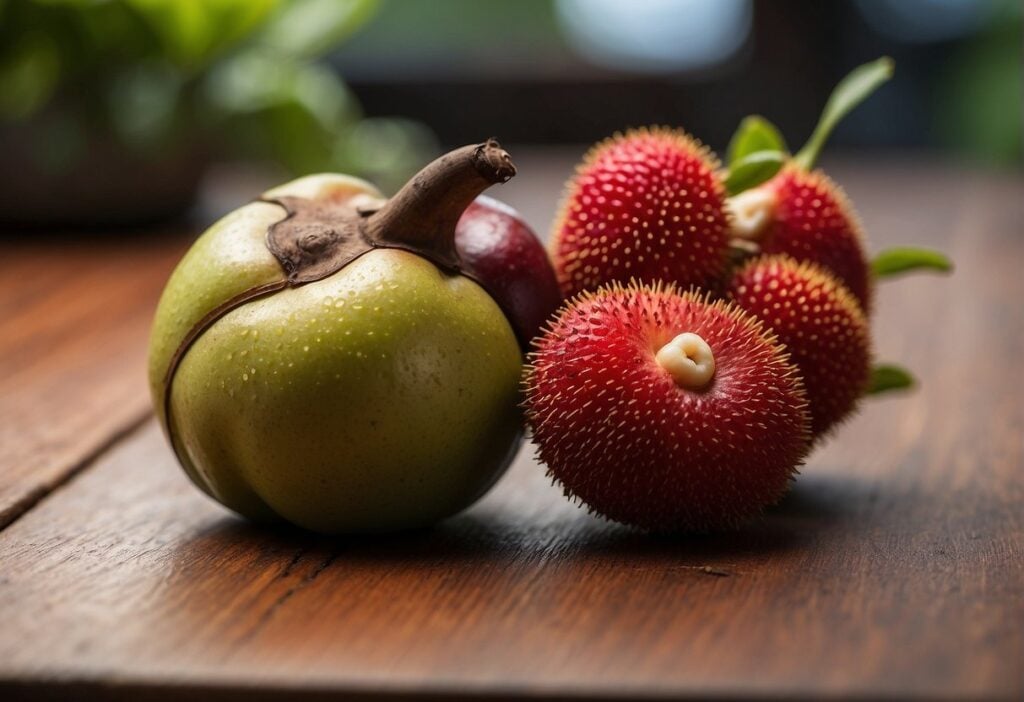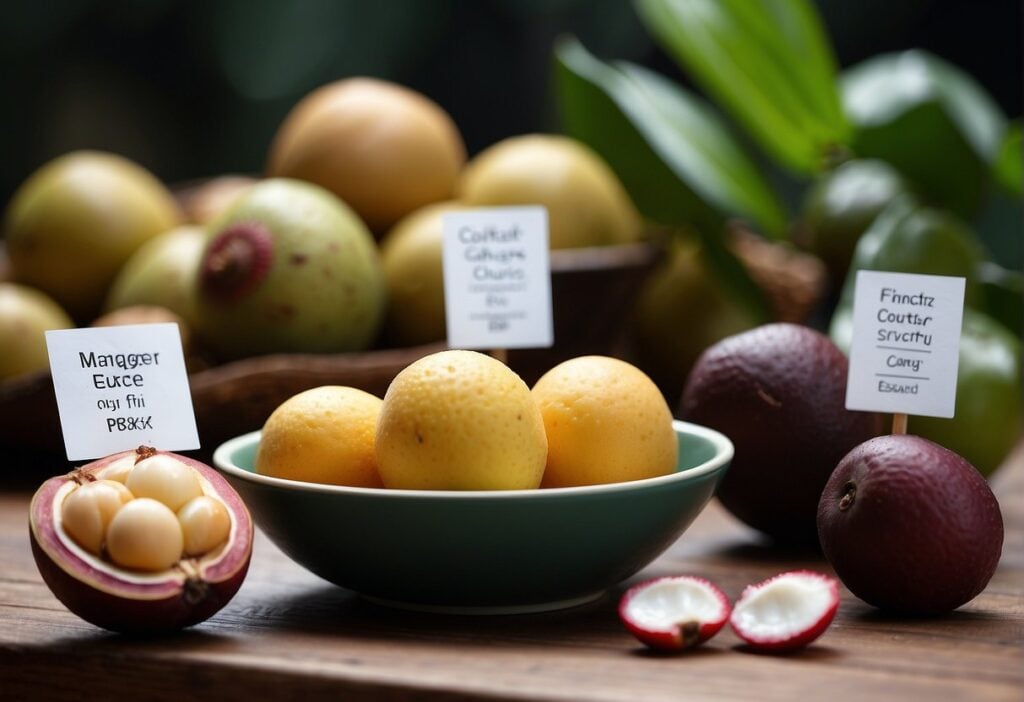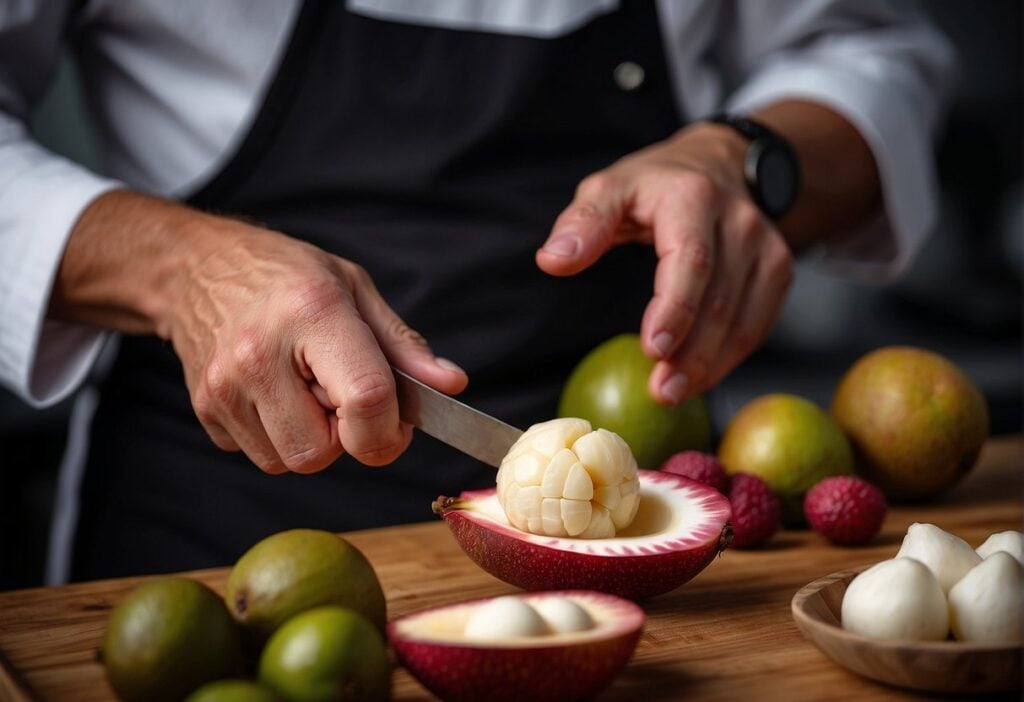Mangosteen and lychee are two exotic fruits that might pique your curiosity if you enjoy exploring diverse flavors and textures.
Native to Southeast Asia, both fruits offer a sweet and tropical taste, yet they differ significantly in several aspects.
Mangosteen, with its thick, purple rind, reveals a white segmented interior with soft, edible seeds, and exudes a slightly creamy, citrusy flavor.
Lychee, on the other hand, sports a bumpy red exterior, peeling away to a translucent flesh that envelopes a large inedible seed, and delivers a burst of sweet and tangy juice.

Understanding the distinctions between mangosteen and lychee can enhance your culinary experiences and help you make informed choices, whether you’re experimenting with new recipes or simply seeking a refreshing snack.
While both fruits can be savored fresh, their unique qualities lend themselves to a variety of dishes, from tropical beverages to exquisite desserts.
With mangosteen’s plush, tender segments, it’s often enjoyed raw or as a delicate accompaniment to both sweet and savory plates.
In contrast, lychee’s intense sweetness and succulent texture makes it a favored ingredient in syrups, cocktails, and Asian cuisine.
When selecting mangosteens and lychees, look for fruits that are heavy for their size, signifying freshness and juiciness.
A ripe mangosteen should yield slightly to gentle pressure and have a vibrant, glossy exterior.
Lychees that are ready to eat typically have a slightly rough skin, and the color turns from bright red to a ruddy brown.
Store them properly, and these tropical delights can provide a delectable escape to a far-off paradise with each bite you take.
Origin and History
Mangosteen, often referred to as the ‘queen of fruits,’ is believed to have originated in Southeast Asia.
This luscious fruit thrives in the warm, tropical climates of countries such as Thailand, Malaysia, Indonesia, and the Philippines.
Mangosteen trees are slow-growing, evergreen and can reach heights of 20 to 40 feet. They bear fruits with a thick, deep purple rind when ripe, containing sweet, succulent segments.
On the other side, Lychee—a fruit known for its delicate and floral sweetness—has its roots in China.
The journey of lychee from China spanned across the neighboring regions, establishing its presence in Southeast Asia, including countries like India and Thailand.
The lychee tree produces juicy, small round fruits, wearing a bumpy red skin that easily peels away to reveal the edible flesh inside.
| Fruit | Origin | Known for |
|---|---|---|
| Mangosteen | Southeast Asia | Sweet, segmented interior |
| Lychee | China | Juicy, floral sweetness |
As you explore these tropical delights, remember that both mangosteen and lychee have been savored for centuries, not only for their unique flavors but also for their reputed health benefits.
Each fruit carries a rich history entwined with the culture and agriculture of the regions they hail from, having established themselves as staples and exotic treats within the tropical fruit pantheon.
Botanical Characteristics

Mangosteen (Garcinia mangostana)
Mangosteen is a tropical evergreen tree that is native to Southeast Asia. It yields the esteemed purple fruit known for its exquisite flavor.
The mangosteen fruit has a thick, dark purple rind when ripe, sheltering the delicate, succulent white flesh within.
Characteristically, mangosteen trees have glossy, dark green leaves and large, rose-pink flowers. The fruit itself is round, with a flattened end, resembling a small orange in size.
- Leaves: Glossy, dark green, 15-25 cm long
- Fruit:
- Size: Comparable to a small orange
- Rind: Thick, hard, deep red/purple
- Flesh: Snow-white, segmented like a mandarin orange
Lychee (Litchi chinensis)
Lychee, another cherished tropical fruit, is borne on an evergreen tree in subtropical regions. This fruit’s outer skin is red and rough with a bumpy texture, significantly different from the mangosteen.
The interior houses a juicy white flesh that is aromatic and sweet in flavor, encasing a large, inedible seed.
- Leaves: Pinnate, composed of leaflets 5-8 cm long
- Fruit:
- Skin: Red, rough, bumpy texture
- Flesh: Translucent white, juicy
- Seed: Large and inedible
Mangosteen and lychee both flourish in a tropical climate, typically requiring a humid environment with well-drained soil.
While mangosteens are more temperature-sensitive, often necessitating a specific range of temperatures to fruit successfully, lychees are slightly more adaptable but still require protection from frost.
Their botanical characteristics distinctly set them apart, with mangosteens being admired for their deep purple exterior and segmented flesh, and lychees being recognized for their distinctive rough skin and sweet, fragrant white flesh.
Nutritional Profile

Exploring the nutritional profiles of mangosteen and lychee provides insight into their unique health benefits. Both fruits are known for their vitamins and minerals, but they also differ in key nutritional aspects.
Macronutrients and Calories
Mangosteen and lychee contain varying amounts of macronutrients.
Lychee is higher in carbohydrates and sugars, which contributes to its higher calorie count compared to mangosteen.
Both fruits have low levels of fat and protein.
- Mangosteen: Low in calories, containing around 63 calories per 100 grams with approximately 15 grams of carbohydrates.
- Lychee: Slightly higher in calories, providing about 66 calories per 100 grams, and contains approximately 17 grams of carbohydrates.
Vitamins and Minerals
Both fruits are rich in essential vitamins and minerals, contributing to their reputation as healthy choices.
- Mangosteen:
- Vitamin C: Important for your immune system.
- Folate: Supports cell division and is crucial during pregnancy.
- Lychee:
- Vitamin C: Contains 76% more Vitamin C than mangosteen.
- Vitamin B6: Essential for metabolism and brain health.
- Copper: Important for red blood cell formation.
| Nutrient | Mangosteen (per 100g) | Lychee (per 100g) |
|---|---|---|
| Vitamin C | Low | 71.5 mg (76% higher) |
| Folate | 31 µg | 14 µg |
| Vitamin B6 | 0.018 mg | 0.1 mg (6 times more) |
| Copper | Less than lychee | 0.148 mg |
Health Benefits
The consumption of mangosteen and lychee is associated with various health benefits due to their nutrient content.
- Antioxidants: Both fruits are rich in antioxidants, which help fight free radicals and may reduce inflammation.
- Dietary Fiber: Contributes to digestive health. Mangosteen provides a good amount of fiber, whereas lychee contains less.
- Immune System Support: Vitamin C in lychee significantly boosts your immune system.
Physical Characteristics
As you explore the world of tropical fruits, understanding the physical characteristics of mangosteen and lychee will greatly enhance your appreciation for these exotic treats. These aspects not only distinguish them but also influence their culinary uses.
Appearance
Mangosteens and lychees exhibit distinct external appearances.
The mangosteen has a spherical shape and is usually 6-7 cm in diameter.
Its rind is thick, rough, and deep purple in color, which, when opened, reveals the segmented white flesh inside.
In contrast, lychees are smaller in size, about 3 cm in diameter, with a rough red or pink peel that is easy to remove, exposing the translucent white flesh surrounding the seed.
Taste and Texture
The flesh of mangosteen and lychee differ in texture and flavor profiles:
- Mangosteen: The flesh is soft, somewhat fibrous, and reminds one of a combination of pineapple, peach, strawberry, and grape flavors. It is sweet with a touch of acidity, which gives it a refreshing balance.
- Lychee: A juicy texture is predominant in lychees, and the taste is uniquely sweet and tangy, somewhat akin to a pear or grape with hints of floralflavors.
Culinary Uses

Mangosteens and lychees offer a range of culinary uses in the kitchen, providing sweet, tropical flavors to various dishes. They can be enjoyed in both fresh and canned forms, enhancing the taste and presentation of desserts and beverages.
Preparation and Consumption
Mangosteen: Before you indulge, you must first remove the sturdy, leathery purple peel to access the soft and juicy flesh inside. The white segments within resemble those of an orange and are typically seedless or contain non-edible seeds.
You can enjoy mangosteen flesh fresh.
Lychee: To consume a lychee, peel away the rough, bumpy skin, which will reveal the translucent and juicy flesh. Be mindful to remove the single large seed found in the center.
Lychees are commonly eaten fresh but can also be found canned in syrup.
Common Pairings and Recipes
Mangosteen and lychee can each bring a burst of tropical flavor to sweet and savory dishes. Here are some ways you can incorporate these fruits into your recipes:
- Desserts:
- Mangosteen and lychee can both be stars in your sorbet or ice cream recipes, bringing a sweet and nuanced flavor.
- Enhance your muffins and puddings by folding in chopped flesh of either fruit for a tropical twist.
- Beverages:
- Blend mangosteen or lychee flesh into smoothies for a refreshing and exotic taste similar to that of grapes.
- Savory Dishes:
- Lychee, with its floral notes, pairs well with robust flavors like black bean sauce and can add a surprising twist to your stir-fries or as a garnish on top of salads.
- Canned Uses:
- Both fruits, when canned, are convenient for out-of-season use and can be added to fruit salads or used as a dessert topping.
Remember, when preparing these tropical delights, to handle the flesh delicately to maintain their integrity and flavor.
Storage and Preservation
Mangosteen and lychee are tropical fruits that require specific conditions for optimal storage to maintain their quality.
For mangosteen:
- Store at a cool temperature, around 10°C (50°F), to prolong freshness.
- Avoid refrigerating as this can cause flavor loss and bruise the juice sacs.
- At room temperature, store them in a cool, dark place if consuming soon.
- Maintain in a plastic bag to retain moisture if not consumed immediately.
Lychee:
- Refrigerate lychees promptly in a plastic bag to slow down ripening, as they are highly perishable.
- To preserve the quality, store in the refrigerator for up to a week.
- For longer preservation, lychees can be canned in syrup. This extends their shelf life but alters the texture and flavor.
Tips for Both Fruits:
- Keep fruits dry to prevent mold growth.
- Don’t wash until ready to eat to minimize moisture exposure.
- Check routinely and remove any fruit that shows signs of spoilage to protect others.
To summarize the storage guidelines in a table:
| Fruit | Temperature | Best Storage Container | Long-Term Preservation |
|---|---|---|---|
| Mangosteen | 10°C (50°F) | Plastic bag | Not recommended |
| Lychee | Refrigerated | Plastic bag | Canned in syrup |
Remember, while canned fruits can keep for longer periods, the sensory quality such as texture and taste will differ from fresh fruits. Always prioritize fresher storage methods to enjoy these exotic fruits as intended.
Market Availability and Varieties
When searching for mangosteens and lychees, you’ll find that their availability largely depends on the region and the season.
In general, mangosteens are less available than lychees outside of Southeast Asia. However, both fruits can typically be found in various ethnic stores or specialized fruit markets across the United States, particularly during their respective seasons.
Lychees:
- Season: Peak availability in the U.S. during the summer months (June to July).
- Varieties: You might encounter different cultivars like ‘Mauritius’, ‘Brewster’, and ‘Hak Ip’.
Mangosteens:
- Season: They usually appear in U.S. markets from late spring through summer (May to August).
- Availability: More sporadic compared to lychees and may not be found in all mainstream grocery chains.
Below is a high-level overview of what you may find in stores:
| Fruit | Season (U.S.) | Varieties/Common Types |
|---|---|---|
| Lychee | June – July | Mauritius, Brewster, Hak Ip |
| Mangosteen | May – August | Mostly standard variety due to limited importation |
Should you seek these fruits outside their typical seasons, you may also find them canned or frozen in some stores, which allows you to enjoy their unique flavors year-round.
Remember, the availability can fluctuate, so during the off-season, your best bet for freshness is at import-focused or specialty markets.
Comparison of Mangosteen and Lychee
Exploring the exotic world of tropical fruits, you’ll find unique features and nutritional benefits in both mangosteen and lychee. This detailed comparison will help you distinguish between these two delightful fruits.
Nutritional Differences
Mangosteen and lychee differ in their nutritional profiles. Here is a brief comparison based on a 100-gram serving:
| Nutrient | Mangosteen | Lychee |
|---|---|---|
| Calories | 73 kcal | 66 kcal |
| Fat | 0.58 g | 0.44 g |
| Protein | 0.41 g | 0.83 g |
| Carbohydrates | 17.91 g | 16.53 g |
| Fiber | 1.8 g | 1.3 g |
| Sugar | 13.7 g | 15.23 g |
| Vitamins/Minerals | Rich in Vitamin C | Rich in Vitamin C |
Both fruits have no cholesterol and are low in sodium. They are also similar in their richness of Vitamin C and other essential minerals.
Culinary Applications
Mangosteen and lychee both contribute to tropical flavors in various culinary applications.
Mangosteen’s soft and matte flesh is used in fresh salads, smoothies, and desserts. Meanwhile, lychee, with its juicier texture, is a popular addition to cocktails, juices, and also complements desserts very well.
- Mangosteen: Ideal for creating purees or as a unique ice cream topping.
- Lychee: Often canned or dried and used in lychee-flavored dishes.
Taste and Texture Contrasts
Comparing the taste and texture of these fruits, mangosteen offers a combination of flavors akin to pineapple, peach, and strawberry. Its flesh is soft.
On the other hand, lychee possesses a sweet flavor that’s reminiscent of a combination of grape and pear, and a juicy texture that’s enjoyed by many.
- Mangosteen: Sweet, creamy, and tropical flavor profile.
- Lychee: Sweet, floral, and slightly tart, more watery texture.
Availability and Cultivation
Mangosteen originates from Southeast Asia, with significant cultivation in Indonesia, Malaysia, and the Philippines.
Meanwhile, lychee hails predominately from China and is widely cultivated there as well as in other parts of Southeast Asia.
- Mangosteen: Rarer in the United States, mainly found in Asian grocery stores.
- Lychee: More common, available both fresh and canned in many supermarkets.
Health Impact
When comparing the health impacts of mangosteen and lychee, your focus might be drawn to their antioxidant properties and dietary aspects. Both fruits offer unique benefits that could complement a health-conscious diet.
Antioxidant Properties
Mangosteen is renowned for its antioxidant capacity, primarily due to compounds called xanthones. These compounds help combat free radicals, which are molecules that could damage cells and contribute to diseases such as cancer.
This fruit could, therefore, play a role in supporting your immune system.
On the other hand, lychee also contains antioxidants, including Vitamin C and oligonol, which have similar free radical-scavenging abilities.
Lychee is higher in Vitamin C compared to mangosteen, which is an important antioxidant for repairing tissues and boosting immune health.
Dietary Considerations
The dietary profiles of mangosteen and lychee are important to consider, especially if you’re watching your intake of calories, sodium, sugar, and fiber.
Mangosteen:
- Calories: Relatively low
- Dietary Fiber: Offers a decent amount of fiber
- Sugar: Contains natural sugars
- Fat: Negligible amounts of fat
- Sodium: Very low in sodium
Lychee:
- Calories: Comparable to mangosteen but slightly higher
- Dietary Fiber: Less than mangosteen, with about 2.5 grams per cup
- Sugar: High in natural sugars
- Fat: Contains minimal fat content
- Sodium: Sodium content is also low
Both fruits have their role in a balanced diet and offer health benefits, yet in different proportions.
Mangosteen has the added advantage of the fiber content which can aid in digestion, while the calories from lychee come with a burst of Vitamin C, making it a sweet yet nutritious treat.
Including these fruits as part of your diet should be balanced with other dietary needs and health goals.
Frequently Asked Questions
In this section, you’ll find specific information addressing common inquiries about the differences between mangosteen and lychee, from their unique tastes to their nutritional values.
What are the taste differences between mangosteen and lychee?
Mangosteen offers a sweet yet tangy flavor with a creamy texture, often compared to a combination of peach, banana, and strawberry.
Lychee, on the other hand, has a sweet, floral taste and a juicy, grape-like consistency.
Can both mangosteen and lychee be eaten in their entirety, including the skin?
The edible part of mangosteen is the white juicy segments inside, while its thick purple rind is inedible.
Lychee fruit is enjoyed by peeling away the rough pink-red skin to reveal the fragrant, translucent flesh inside; the outer skin is not consumed.
How do the nutritional profiles of mangosteen and lychee compare?
Both fruits are rich in vitamins and low in fat.
Mangosteen contains potent antioxidants, vitamins C and B6, and fiber, while lychee provides a good amount of vitamin C, fiber, and also vitamins B6 and potassium.
What is the calorie count difference between mangosteen and lychee?
Lychee contains approximately 66 calories per 100 grams, while mangosteen has slightly more, with about 73 calories per 100 grams.
Which fruit is often confused with mangosteen due to similarity?
Rambutan is the fruit that’s most commonly mistaken for mangosteen because of their similar appearance, with a round shape and a hairy outer skin, although their tastes are quite different.
Which is referred to as the ‘queen of fruits’, mangosteen or lychee?
Mangosteen is often called the ‘queen of fruits’ due to its rich, exquisite taste and nutritional benefits.
- Raisin vs Sultana - March 12, 2024
- Pairing Ratatouille with Wine and Beverages - March 12, 2024
- Polenta in Argentine Cuisine - March 11, 2024
















